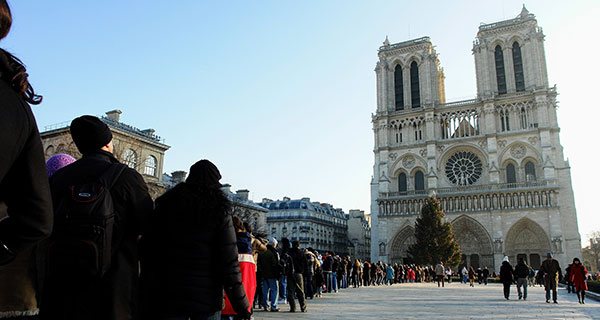 Fire destroyed much of Notre Dame de Paris on Monday.
Fire destroyed much of Notre Dame de Paris on Monday.
The loss is impossible to calculate. Whatever rebuilding efforts the French government and the Catholic church mount, the building will never be what it was. It’s almost best that they leave the ruins as they are.
But rebuild they must.
I visited Notre Dame once. It was a postcard morning. We visited the Left Bank, then toured the great cathedral. The interior was dark, the stone cool. We studied the rose windows, sparkling like medallions.
In the cathedral, I encountered profound seriousness. For the people who built the cathedral, life had great significance and so it had to be lived seriously. The apocalypse carved over the main entrance reminded the faithful that what they did to one another was never morally neutral. All would be made even.
A building like Notre Dame casts us moderns, who think we’re so smart, in a pallid light. Our architecture says as much about ourselves as architecture represented the people of the Gothic age. The towers rising in Toronto – identical to towers rising all over the globe – communicate the low-pointing attitude of our times. And the few buildings that aspire to something higher more often than not point to the massive egos of the architects who ‘designed’ them.
As I watched Notre Dame consumed by flames, I learned that I’m not the only person who feels like something more than the church has burned – and is burning. The inferno of 2019 is a towering metaphor.
First to the Catholic church, burning as it is with the decades-long scandal of child abuse, the more recent revelations of sexual harassment of men inside seminaries, and the turning away of so many of the nauseated, disenfranchised flock.
Second to the soullessness of our distracted age. Who has the time or the dedication – or sincerity and humility – to mount the efforts that a faith like Christianity demands of its followers?
I saw a video of people crying as the church burned. What were they mourning when they saw the flames – the loss of irreplaceable art or the loss of the possibility of transcendence?
And third to the determination by so many Westerners to repudiate their past and destroy their traditions. The levelling of Notre Dame looks so much like the self-evacuation of the historical consciousness of so many of us in the West. In our efforts to refashion ourselves as a forward-thinking civilization with openness as our highest value, we’ve had to dispense with the old myths, relativize our outlooks and dole out shame in equal portions.
In seeing Notre Dame in ruins, I began to see how impossible it will be for the new secular to replace the old sacred.
The secular – denuded, inoffensive, scentless, without sharp edges, safe for all to handle – doesn’t have the foundation to carry the civilizational load it must handle. The only way it can is if we contort ourselves and logic. In other words, if we lie about what a human society needs to sustain itself.
The destruction of Notre Dame gives us a glimpse of what we will lose if certain reformers in our society succeed in telling us how we should think about the past. The story is old, the message constant: if you kill your father, you end up fatherless.
No, there is no dignity in destroying a tradition. To believe there is requires a person to buy the lie that what’s ugly can be beautiful. The statement destroys both words, but we lose more when we lose beauty.
Robert Price lectures at the University of Toronto Mississauga.
The views, opinions and positions expressed by columnists and contributors are the author’s alone. They do not inherently or expressly reflect the views, opinions and/or positions of our publication.












